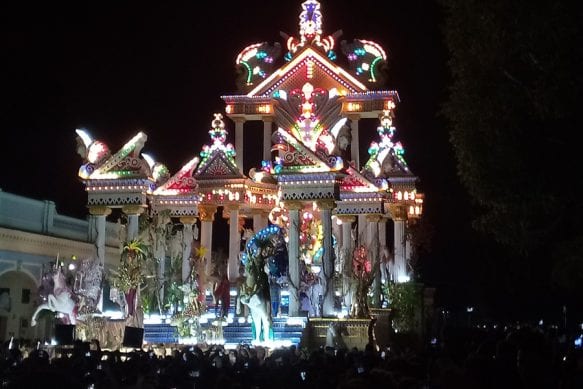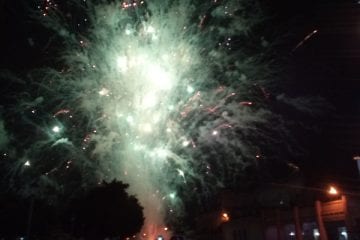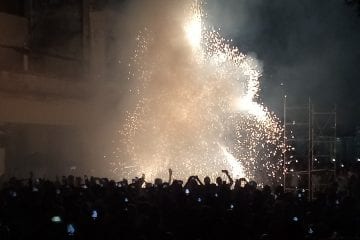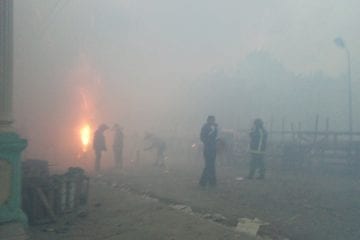Cuba’s “Parrandas” a Tradition in Danger of Being Lost
These are popular festivities in Cuba’s interior provinces, which were declared Intangible Cultural Heritage by the United Nations Department for Education, Science and Culture.

HAVANA TIMES – Even though he left 20 years ago, Ivey Diaz returns to Camajuani every March when it’s parade time. As a child, his mother worked in the San Jose (Sapos) Neighborhood’s dressing room while he made small floats with bits of scrap material.
“This passion doesn’t ever leave you, it doesn’t matter where you go,” he told IPS, after the last edition of these annual festivities, on March 19th, when the community splits up and two neighborhoods, Sapos and Santa Teresa (Chivos) enter a friendly rivalry.
Both groups compete to show off the flashiest float, the best firework display or the most popular changui (parade), in this municipality of the interior of Villa Clara province.
After 125 years, this continues to be the town’s most important sociocultural event, although the majority of residents claim that there has been a loss of “procession spirit”, especially among younger generations.
What is being lost?

According to Eloy Gonzalez, president of the Santa Teresa neighborhood for almost thirty years, this alleged apathy among young people is due to the disappearance of many features of the tradition, including the Palenque (a kind of firework that announces the beginning of the float’s route) and lights in the changuies.
While other parts of the celebration such as the bugle procession, a parade that announces, at dawn, the beginning of the competition between the town’s neighborhoods, has been devalued so much that it runs the risk of being lost forever, he laments.
“Many of us still love the procession, but we lack motivation. Before, the entire town worked all year round for their neighborhood, now they only work two or three months, and almost no one goes to the workroom,” Gendry Bruzains said, a young art teacher who used to make the big-headed figures, dolls made out of papier-mache, which are emblematic of this town’s parades.
On the other hand, this used to be a family and community gathering which has had to turn to external help in recent years in order to carry on running.
“There are still entire families who work on the float but, there are less and less local artists (a phenomenon that extends to other towns) and so we have to bring them in from other communities. This tradition isn’t being promoted in the neighborhood,” Diaz explained, who comes every year, from abroad, to help with the procession’s preparations.

Building the monumental floats, that Camajuani is famous for, requires project managers, designers, costume makers, sculptors and painters.
Asdrubal Martinez, member of the San Jose (Sapos) Neighborhood board, believes that this exodus was the natural result of the local tourism industry’s growth, which has one of the country’s main resorts, Villa Clara’s North Keys, and most of its workforce comes from neighboring towns (Camajuani, Caibarien and Remedios).
Nevertheless, there is local talent that isn’t being made the most of, according to Bruzains. This “import of float-makers”, as it is called, is interpreted by many locals as a loss of authenticity and the commercialization of this traditional celebration.
“People who come from outside the community don’t come because they share the neighborhood’s spirit and love for the tradition, but because they are being paid,” Eloy Gonzalez ended.
According to this veteran float-maker, it’s necessary to bring education centers and workrooms closer together, as the latter are open all year round to prepare the celebrations.
Using social media has also been effective in attracting the younger generations who are glued to communication technology, Garcia stated, one of the administrators of the “Parranderos de Camajuani” Facebook page, which live broadcast the departure of the floats in 2019.
Increasing security and the implication this has had on the processions has also been a much-debated subject. According to many, new measures (mostly restrictions on the use of fireworks) detract spontaneity and quality from the celebrations, which is an essential safeguard in other people’s eyes.

In 2018, this community lamented the loss of a human life because of a firework accidentally going off in the San Jose neighborhood.
The Chivos president believes that they can uphold this tradition without running any risks. Things just need to be better organized and a strategy be better outlined by all parties involved: the government, neighborhood and police, but it still hasn’t been defined.
How much does it cost?
The processions are funded with a municipal budget, collections from the neighborhood, the support of the emigre community and other local players.
The Municipal Assembly of People’s Power (government) allocates a budget of approximately 3,500 USD per year to each of the neighborhoods, which come from the 1% of taxes for local development.
This sum is far from enough given the magnitude of these floats, which are normally 36 meters long, 15 meters wide and 25 meters tall. Then, there are fireworks, congas, announcer expenses, as well as other necessary costs, Martinez explained.
Given the irregularities in the national supply market, Gonzalez identified that it is crucial that the government helps with the allocation of materials such as wood, paint, cables, etc., which are still hard to find in empty stores even when they have cash in hand.

The procession community abroad also contributes by importing products that are in shortage or very expensive on the Caribbean island, such as fabrics and other costume accessories.
In the meantime, some private businesses help to support them, especially those who are dedicated to making handmade shoes, an activity which Camajuani is famous for and one of the town’s main sources of revenue.
This support almost always comes in the form of resources that no longer exist via legal channels, so that non-governmental organizations can make direct donations.
For a few years now, Sapos and Chivos have tried to increase funds available with their own incomes, so they rent out their floats to carnivals in other cities such as Cienfuegos, Santa Clara and Matanzas, for example.
The heritage value of these floats could be the heart of a local development strategy in this town, which is geographically located among one of the interior’s greatest tourist destinations, the city of Santa Clara and Cayo Santa Maria.
The project has already been presented to the local government, but hasn’t received a response as of yet, Asdrubal Martinez stated.
According to this university professor, “the processions could be linked to other historic attractions, such as the Slave Route, in a project that benefits the community and helps us to uphold this tradition. Unfortunately, when it comes to matters of local development, Camajuani is far behind the rest of its neighboring towns,” he explained.
“It has been a procession town since 1894. However, we need to draw up a plan to save this tradition because in 30 years’ time, these Processions might no longer exist,” Gendry Bruzains weighs in.





